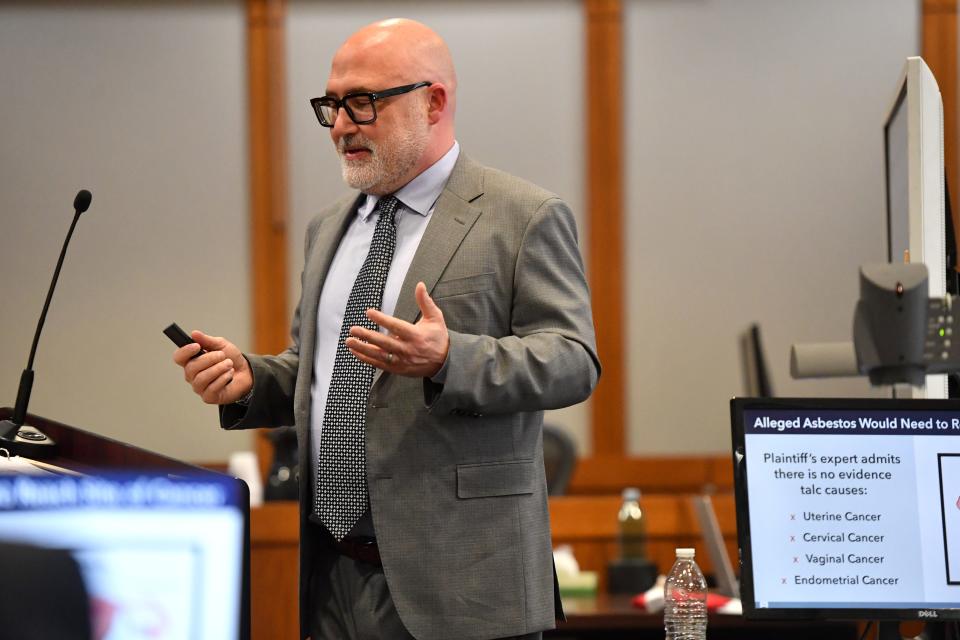Trial against Johnson & Johnson: Expert testifies to what was found in baby powder
During the course of two days, a molecular biology and microscopy expert was questioned extensively about whether there was asbestos in Johnson & Johnson's baby powder and if Pat Matthey had been exposed to it.
Dr. Mark Rigler, the CEO and sole employee of consulting services firm Aspex LLC, said the Johnson & Johnson baby powder he was asked to test had fibrous talc particles in it, meaning it was contaminated with asbestos.
Rigler was a laboratory manager at Materials Analytical Services at the time and was involved in overseeing the testing of the powders provided to the laboratory. He was later retained by the plaintiffs as an expert in their case.
Previously: Sarasota jury hears opening statements in wrongful death trial against Johnson & Johnson
More: Civil trial to begin soon in Sarasota against Johnson & Johnson. Here's what we know
The family of Patricia Matthey sued pharmaceutical and medical technology company Johnson & Johnson for product liability and wrongful death.
In August 2016, Pat Matthey was diagnosed with ovarian cancer. A little over two years later, she filed her lawsuit in Sarasota County, where she was a resident, alleging that her cancer was linked to the talc-based baby powder produced by Johnson & Johnson which she had used for more than 50 years.
Patricia Matthey, 72, died in November 2019 after a long and painful battle with Stage 4 ovarian cancer, according to attorney Lance Oliver during opening statements. Her son, Philippe Matthey, is suing on behalf of his mother’s estate.
Over the decades, there have been varied opinions from scientists, researchers and government agencies about whether talc-based powders increased the risk of ovarian cancer in women.

Talcum, or talc, is a soft, naturally occurring mineral mainly made up of magnesium, silicon and oxygen, and is often found in mines with asbestos.
A similar lawsuit tried in Miami earlier in March ended in a mistrial due to a hung jury. It’s expected to be tried again later this year.
Following the mistrial, Johnson & Johnson released a statement that its baby powder "is safe, does not contain asbestos, and does not cause cancer." The statement also indicated that Johnson & Johnson has prevailed in 15 of 16 similar lawsuits.
Was there asbestos in Johnson & Johnson’s baby powder?
Lance Oliver, attorney for the family, called on Rigler Friday morning to testify about whether Johnson & Johnson’s talcum-based baby powder had asbestos in it.
His research found that 18 out of 27 bottles of Johnson & Johnson's baby powder which were tested, or 67%, were positive for asbestos, while 18 out of 23 bottles of Johnson & Johnson's Shower to Shower product, or 78%, were positive for asbestos, according to testimony.
When asked by Oliver if Pat Matthey had been exposed to platy talc, fibrous talc and asbestos from her extensive use of Johnson & Johnson’s baby powder over more than 50 years, Rigler said in his opinion she had been. He added later in testimony that when he measured the aspect ratio, or the size, of the talc found in Pat Matthey’s tissue sample it matched the same size of cosmetic talc used in baby powder.
However, Oliver clarified that there was no way to confirm 100% that the talcum powder in Pat Matthey’s tissue was that from Johnson & Johnson because its logo wasn’t on the particles.
Keep reading: Johnson & Johnson marketed baby powder to Black women amid cancer concerns, lawsuit says
More: Johnson & Johnson proposes to pay nearly $9 billion to settle talc powder lawsuits
The best we can do is say it's the same size and shape, Rigler said.
Morton Dubin, the lead attorney representing Johnson & Johnson, pressed Rigler on Monday that he hadn’t been the laboratory manager at MAS when samples of baby powder from museum bottles were tested in 2018 and 2019. According to Rigler’s testimony, the samples from the baby powder bottles that were in the museum had found asbestos fibers in them.
Rigler said he had been a laboratory manager at the beginning when MAS was first contacted about analyzing the powders, and while his title may have changed during the time that the lab was doing its testing, he still worked closely on the project.
Dubin's questioning also clarified that there was no asbestos found in Pat Matthey's tissue samples.
What is the difference between fibrous and platy talc?

Both platy and fibrous talc are simply differing forms of the mineral, with fibrous talc appearing as elongated and needle-like when viewed under a microscope and is classified as a carcinogen by the National Institute of Health. Platy talc appears like stacked plates when viewed under a microscope.
Rigler said that after testing Pat Matthey’s tissue samples, he found platy talc, but not fibrous talc or asbestos.
Rigler also said that Pat Matthey had used far more than 10,000 applications of Johnson & Johnson's baby powder since she was about 18 years old.
Dubin pointed out to the jury that Rigler never tested any of the baby powder bottles that Pat Matthey used, with Rigler concurring he'd never been asked to do so.
Dubin also pointed out that in 2020 during one of Rigler's depositions, Rigler said he couldn't say what Pat Matthey's exposure to asbestos was at the time beyond the ambient amount, or the amount of naturally occurring in the atmosphere. Dubin's questioning revealed that Rigler said it would have been speculative to give a concrete answer about Matthey's level of exposure to asbestos during his deposition, but after reviewing and thinking about the level of exposure since then, he was able to adjust his opinion.
Debate between asbestiform and non-asbestiform characteristics heat up courtroom
More than once throughout Monday, attorneys on both sides raised argumentative objections during the process of questioning Rigler.
Dubin attempted to point out that some of the "asbestos" found in the samples of Johnson & Johnson's baby powder taken from bottles that had been in a museum were only classified as asbestos because of the shape and size of the fiber, rather than the habit, or its growth pattern.
Using a standard wooden ruler as a visual aid, Dubin pressed Rigler about the fact that if a structure appeared elongated and needle-like under the microscope, it was counted as an asbestos fiber.
Rigler said he called it asbestos based on shape and because it fell under regulations by health agencies like the Environmental Protection Agency and Occupational Health and Safety Administration which define what asbestos is, meaning it must be one of the six types of asbestos and be in the asbestos growth habit.
The six types of asbestos that have been referenced throughout the trial include chrysotile (white asbestos), amosite (brown asbestos), crocidolite (blue asbestos), anthophyllite, tremolite and actinolite.
Dubin pointed out that simply because a structure is elongated, doesn't mean it's asbestos. He added that tremolite is much more common in its non-asbestos form in nature than the asbestos form.

Pattern of calling samples with 'asbestos' contaminated
Late Monday, Oliver reviewed internal Johnson & Johnson memos and letters from McCrone labs with Rigler which seemed to point to a pattern of Johnson & Johnson blaming any findings of chrysotile asbestos, commonly known as white asbestos, on contamination.
McCrone Labs was an outside laboratory that Johnson & Johnson used in the 1970s for testing its products, according to evidence presented at trial.
Amid cancer lawsuits: Johnson & Johnson to end sales of talc baby powder globally next year amid cancer lawsuits
Study: No strong link between baby powder and cancer, study finds
“That if you find chrysotile in the sample, it's because of contamination," Rigler said in response to if he saw a pattern from the documents.
In response, Dubin asked Rigler if he thought the individuals who said that the "positive" chrysotile findings were in contaminated samples were lying, Rigler denied the question. He simply pointed to the pattern in the documents.
Dubin also questioned if Rigler knew where the samples that were being referenced came from, specifically if it was from the Windsor Mines in Vermont which were mined for cosmetic talc. When Rigler said he didn't, Dubin pointed out that the particular samples hadn't come from Vermont, but rather a mine in California that had industrial talc, not talc used for cosmetics.
Dubin pointed to an independent 1975 study done by Havard and NIOSH, the National Institute for Occupational Safety and Health, in which the study concluded that there was no asbestos found in the Vermont talc mines.
Oliver questioned how independent the study was if corporate representatives seemingly influenced the results with suggestions and comments on the proposed draft of the paper.
Gabriela Szymanowska covers the legal system for the Herald-Tribune in partnership with Report for America. You can support her work with a tax-deductible donation to Report for America. Contact Gabriela Szymanowska at gszymanowska@gannett.com, or on X: @GabrielaSzyman3.
This article originally appeared on Sarasota Herald-Tribune: Jury hears from expert about if asbestos found in J&J baby powder

